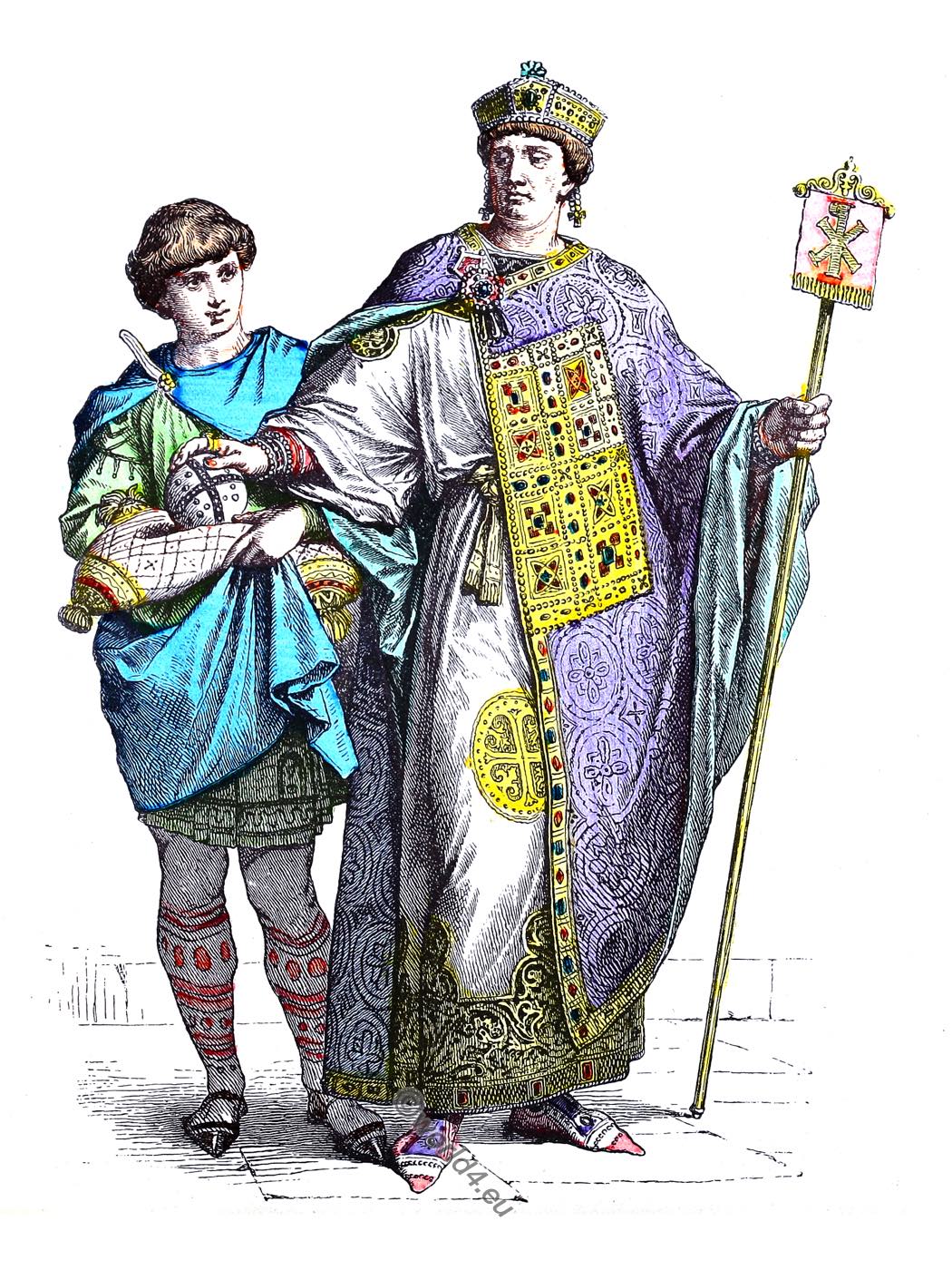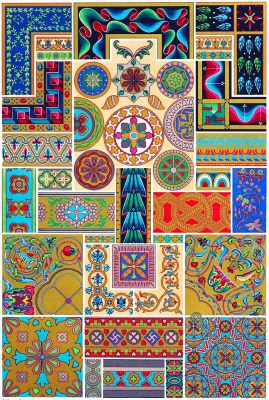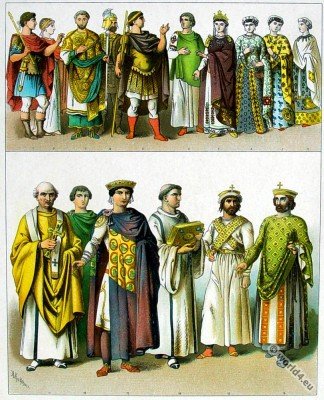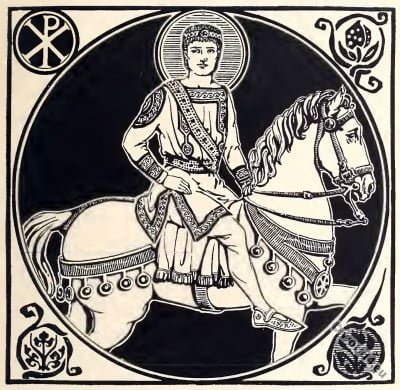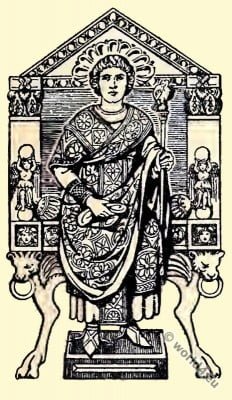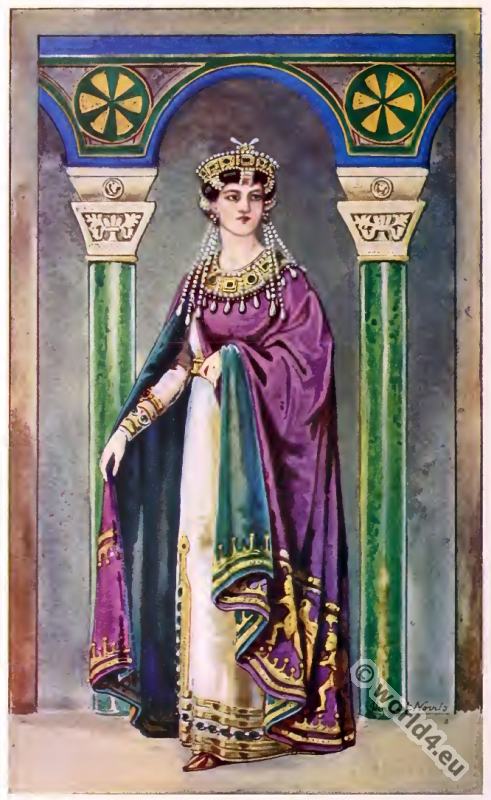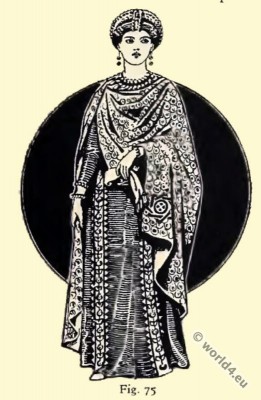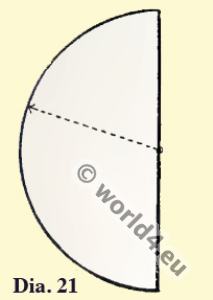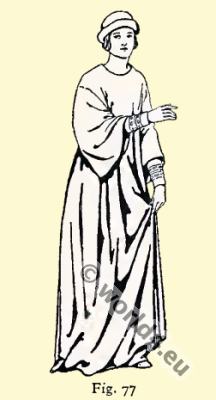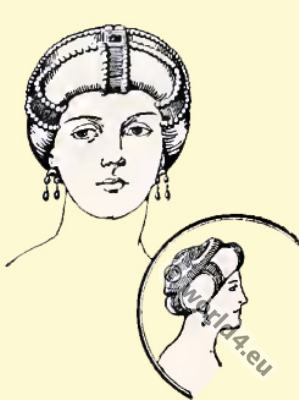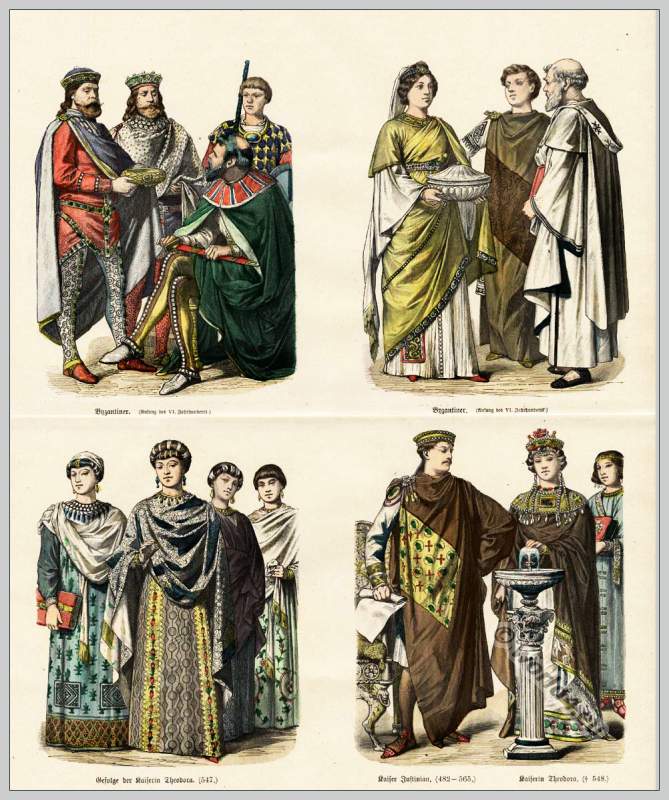Fashion and costume history of the Byzantine Empire. 5th to 6th century.
It should be understood that the Byzantine Empire was known also as the East Roman Empire, the Eastern Empire, and the Greek Empire.
- The East Roman Empire, because it was a transplantation to Constantinople of the original Roman traditions, government and culture, incorporating therewith Oriental influences. In the result it was merely a branch of the Roman Empire in the East.
- The Eastern Empire, to distinguish it from the Western Empire — that of Rome.
- The Greek Empire, because the national elements of Classic Greek culture, its art, literature, and intellect, became more and more the dominating expression of the people; and about the sixth century its traditions were the ruling force of the Empire. Its official language was Greek, and, when the Early Christian Church divided in 729, the Eastern portion at Constantinople called itself the Orthodox or Greek Church. Vast numbers of its inhabitants, who had maintained Roman character and traditions, were carried off by the Great Plague of 747, and were replaced by pure Greeks with no inheritance of Roman tradition behind them.
Rise of the Byzantine Empire.
In the year 660 B.C. a small band of emigrants set out from the town of Megara, a port on the Isthmus of Corinth, whose inhabitants at a later period claimed to be the originators of Greek comedy. The destination of these emigrants was the promontory where Europe is divided from Asia by the strip of water now known as the Bosphorus. There they built their rude huts, and surrounded them with primitive fortifications, naming the place BYZANTIUM.

This small colony of Greeks existed through six centuries of continual warfare, but Byzantium was eventually taken by Rome in A.D. 73 and finally reduced to ruins in A.D. 196. This splendid position—a connecting link between the Western and Eastern civilized worlds—recommended itself to Constantine the Great, who founded a city in 328 upon the same site and called it “New Rome,” but later it received the name of its founder CONSTANTINOPLE, which was used alternatively with the original name, Byzantium.
This new city became the capital of the Byzantine, Greek or Eastern Empire, founded in 394 by Theodosius the Great, when he divided the Roman Empire into the Eastern and Western. The Byzantine Empire lasted for ten and a half centuries, and for a long period its capital was the most important centre of civilization in the world.

In the sixth century a.d. Constantinople presented a magnificent spectacle, when viewed from the deep blue Sea of Marmara. Its outer walls, seven feet thick and thirty feet high, connected a chain of towers, and enclosed a second wall fifteen feet in thickness, and in places fifty feet in height. This wall also connected high towers, ninety-seven in number. Beyond these fortifications stood the city, upon a series of gently sloping hills. The long oval-shaped Hippodrome contained, amongst other ornaments, the four bronze horses made by Lysippus, sculptor to Alexander the Great, which were transported thither from Rome by Constantine. The immense Imperial Palace was at the north end, and beyond that again the Basilica of Divine Wisdom — Sancta Sophia stood out conspicuously in its dazzling whiteness, surmounted by cupolas of gold. The church of S. Irene, the baths of Zeuxippus, the serpent column brought from Delphi, the obelisk erected by Theodosius I., and his triumphal arch or Golden Gate — all these marvellous buildings were backed by a vista of the Nicomedian Hills and the snow-capped peaks of the Bithynian Alps.
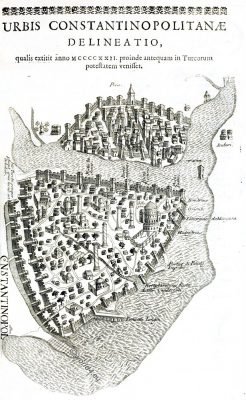
Some details of the Palace of the Emperors have come down to us. It was a city in itself, built upon the shores of the Bosphorus; and at the water-stairs an Imperial galley was always kept in readiness, in case of necessity for sudden flight.
Inside, the golden roof of the audience-chamber was supported by columns of pure gold and silver, and its walls were covered with hangings of silk and embroideries, and of pure gold glistening with precious stones. The furniture of massive, quaint shape was of cedar-wood, overlaid with gold leaf 1) and upholstered with gorgeous materials.
Ornaments of goldsmith’s work were intricately pierced and filled in with colored enamels, and upon the marble floors were laid carpets of silk, of Persian make and strange design.
The centre of all was the Imperial throne, shaped like a tabernacle, all of gold, set with an enormous quantity of jewels. Over it was a cupola raised on four columns, sur- mounted by eagles with wide- spreading wings. Over the throne was a large bejeweled crown, with ropes of priceless pearls attached to it, suspended by golden chains from the ceiling. On either side of the marble steps that led up to the throne were two life-sized lions of massive gold 2), which roared mechanically when it was considered expedient to overawe any suspicious or unwelcome suppliant. Behind these lions stood two huge Egyptian pylons, and directly behind the throne rose a golden plane tree, on the branches of which little birds of all kinds, wrought in goldsmith’s work, jewels, and enamel, sang for the amusement of the Court. In the midst of this exotic Oriental magnificence sat immovable an apparently diminutive figure, almost lost in costly robes of gold smothered in jewels and pearls: “My Eternity,” “My Mildness,” “My Magnificence” 3); The Emperor!
1) An idea borrowed from the ancient Assyrians and Egyptians.
2) Accredited by some to the Emperor Theophilus (829-842). In the 9th century, during a period of bankruptcy, these were melted down.
3) Titles by which the Emperor signed himself.
A Spanish Jew, Benjamin of Tudela 4), visited Constantinople in the twelfth century, and gives a similar glowing account of the wealth and wonder of the place.
To this great city, which had become the emporium of the world, came the merchant galleys of all nations. East and West. Caravans from almost unheard-of districts of Northern and Eastern Asia journeyed over the arid plains and highlands, laden with vast wealth, which was poured into the storehouses of Byzantium; and, in return, Byzantine merchants distributed works of art, manufactures, and commodities of every description to far-off lands. This being so, it was not impossible for a piece of silk to travel from China to Britain via Byzantium.
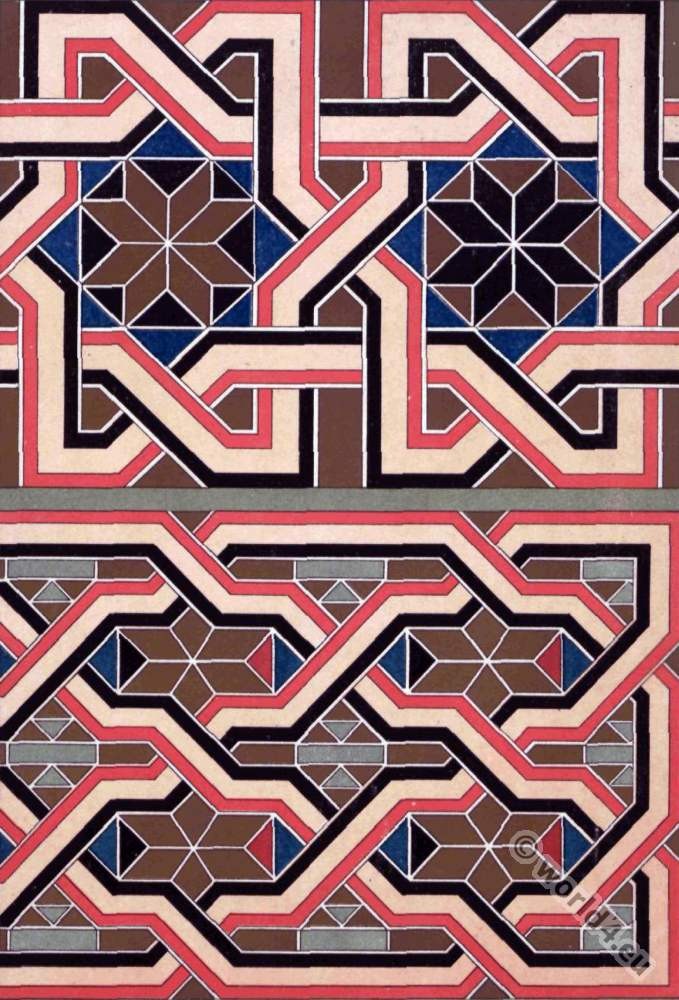
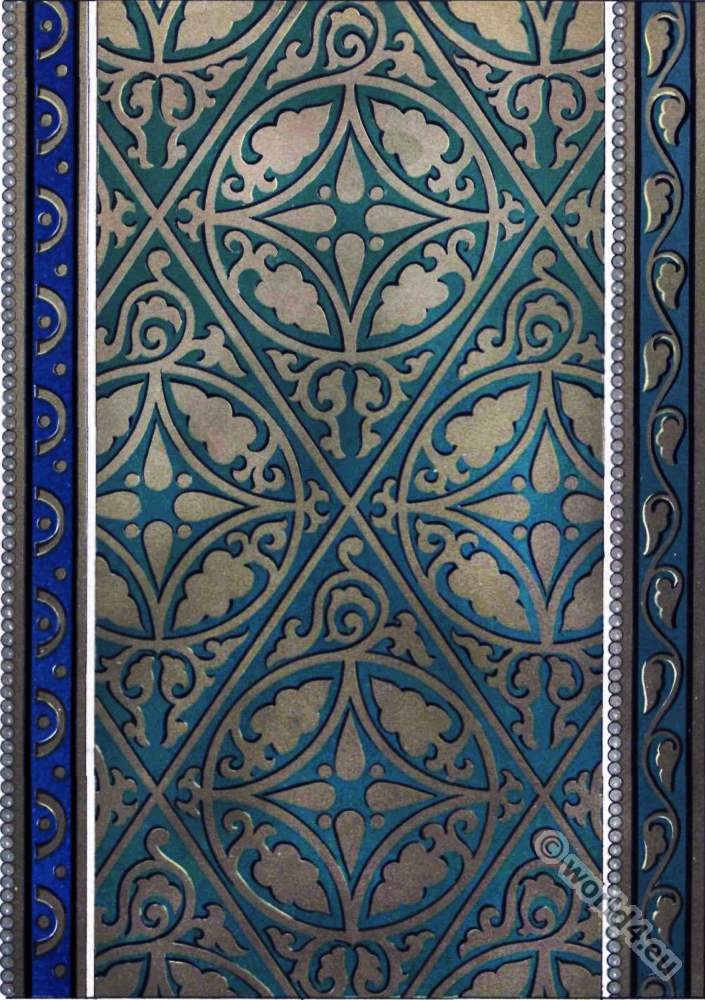
Byzantine culture reaches the West, North and South. But a fact equally important was that the East, from whence civilization and the arts proceeded, came into closer touch with Western lands. Foreign trade contributed largely to the spread of civilization. In fact, the influence of Byzantine culture, and especially art was far reaching and worldwide. In the West, Italy was the first to come under its power, its chief centers being Rome and Ravenna; later, Pisa, Venice, Padua, Parma and Messina. The Franks of the Merovingian Period, and later the Empire of Charlemagne (Germany), were affected by it. As early as the sixth century it penetrated as far as England, Ireland, Scotland, Scandinavia and Iceland. In the north it reached the Slavonic races of Russia and the Balkans, and in the south. North Africa.
4) Benjamin of Tudela, also Benjamin ben Jona, actually Benjamín bar Jonás de Tudela (born approximately in the first decades of the 12th century in Tudela in the Kingdom of Navarra; † ca. 1173 in Castile) was the most important Jewish traveller of the Middle Ages. All information about him comes from his travelogue “Massaot Binjamin mi-Tudela”.
The Fifth Century A.D.
To the Western civilised world Rome was the centre of fashion from the year 146 B.C. to a.d. 400. Byzantium was the centre of fashion and civilisation from the fifth to the twelfth century. Its influence can be traced in varying degree in the costumes and manners of the Courts of ruling princes, in the castles of the nobility and the homes of the people, in every civilised country throughout Europe, from the fifth century until late in the Middle Ages.
Byzantine costume history.
This period shows the beginnings of those extravagant tendencies which, increasing during the following centuries, were to culminate in the eleventh century in a wild orgy of sartorial magnificence. Previous to the opening of the fifth century, the Eastern and Western Empires had become separate dominions (394). Constantinople was on the upward grade, but Rome, during the next eighty years (394-478), was flickering her last before final extinction.
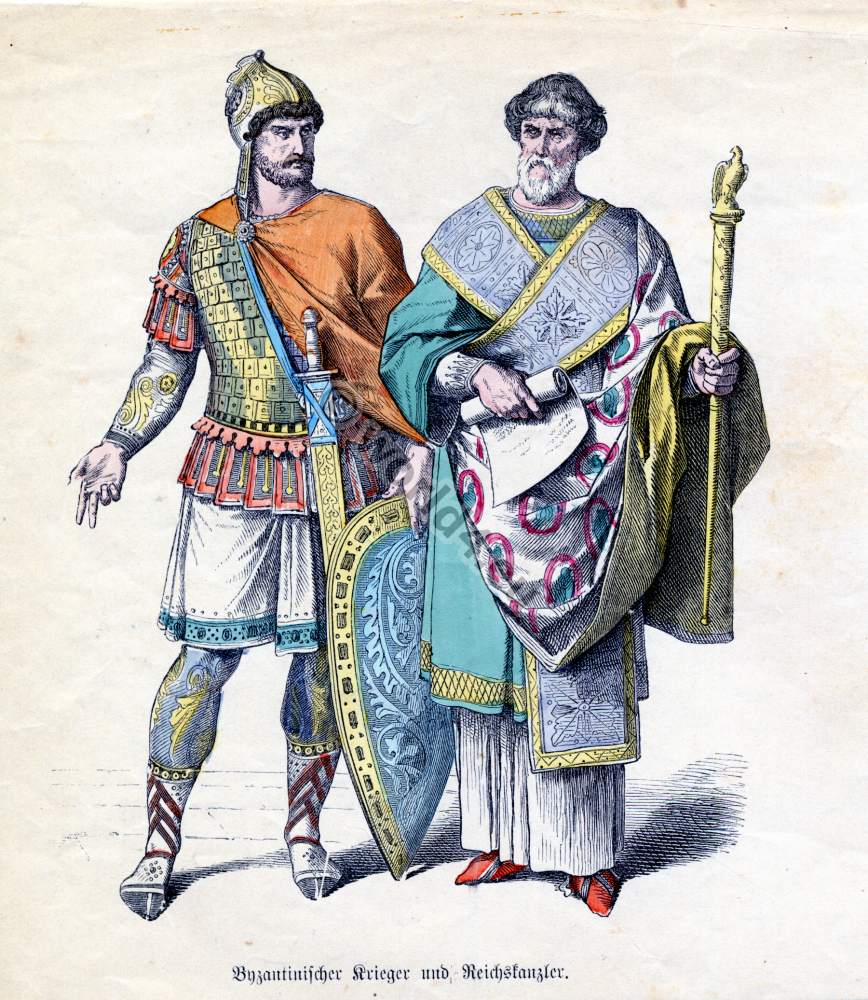
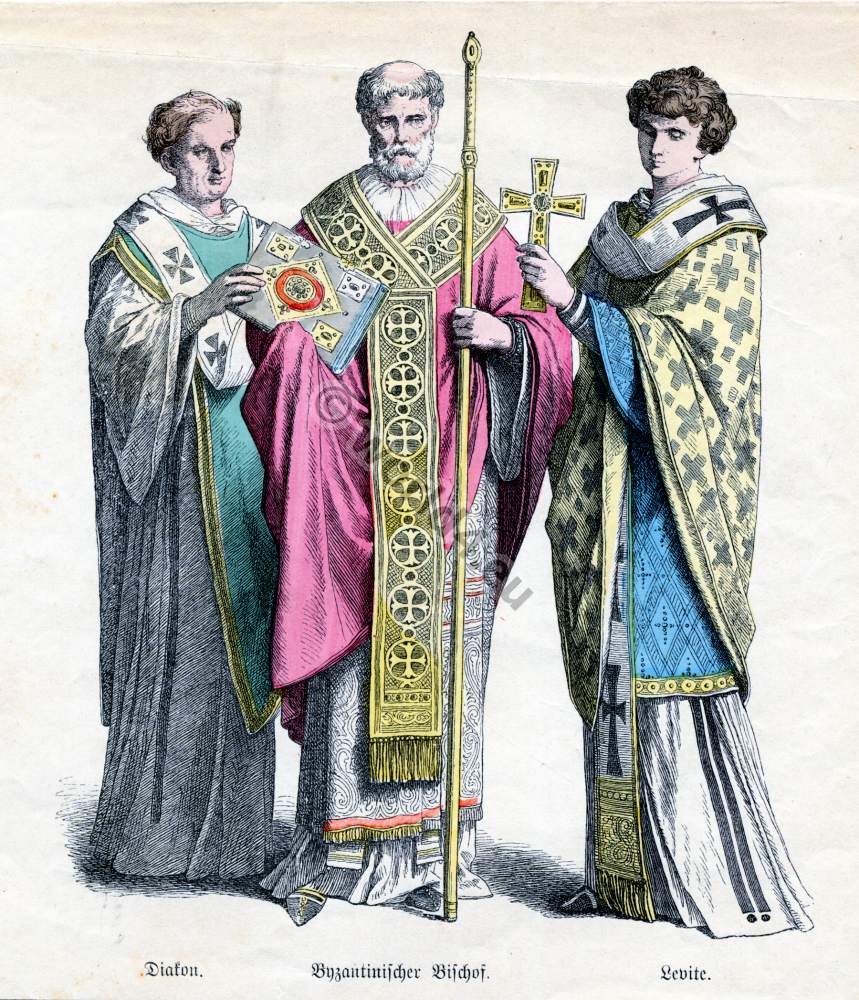
Description of above picture: Byzantine empire costumes, 300-700 A.D.
One feeble effort was made during this time in the cause of costume. It had no immediate results, but it was the first stroke in breaking down the barrier of a long-standing tradition—a feat accomplished a century later.
A decadent people always strains after a new or eccentric idea. In the midst of the horrors of war, famine, pestilence and siege, a craze swept over the pleasure-loving, frivolous youth of Rome. It was during the terrible barbarian inroads into the Empire of the West, towards the end of the fourth and beginning of the fifth century a.d., that it became the fashion among Roman dandies to imitate the costume of their Teutonic invaders. Degenerate fantastics paraded the streets and public ways of Rome, and probably of Constantinople (although the Byzantines were of much saner mentality), dressed out in the loose bracco, fur tunicas, long hair, and barbaric ornaments peculiar to the Teutonic peoples. The Emperor Honorius (395-423) endeavored to crush this ridiculous vogue by issuing three edicts, and he succeeded for a time; for these barbaric fashions were but freaks of a moment, and were not followed by eminent men or leaders of “Society.”
It has been noted already that the paludamentum superseded the toga picta for full State dress.
It was during the early part of this century that it became, without exception, the Orthodox Imperial Mantle. It was worn by the last emperors of the West, all future emperors of the East, and of empires to come.
In colour it was always purple, and its shape as shown in Diagram 17. Its length was greater than as used before, reaching to the ankles. At first it was made of plain material—silk of the richest and heaviest quality obtainable. As each century dawned and faded, the material of which the paludamentum was composed became more and more rich and Ornate. Often it was embroidered in heavy gold and encrusted with jewels, chiefly pearls—pearls by the million—until its surface was almost entirely covered. When the silk-weavers, installed at Constantinople by Justinian, became expert in the art of weaving brocade, this material was used, and was frequently superimposed with embroidery and gems.
A distinctive feature of the paludamentum, or State mantle—for that is what it had now become—was the square or oblong decoration placed on the edge of the sloping side (see A in Diagram 17), back and front.
This was called the TABLION. However rich the paludamentum might be, this particular piece of ornamentation surpassed it in splendour. The paludamentum was worn not only by the emperor, but, in the sixth and following centuries, by the empress also. No other women were permitted the use of it. It was worn by courtiers and high officials in the empire, in all colours except the Imperial purple, but not so richly decorated.
The Tunica.
Details of the tunica were concluded under Imperial Rome. No further change took place in its shape, but a few modifications occurred from time to time and are duly noted in this history.
The Dalmatica.
The dalmatica, in the course of a short period, became merged in the tunica, the only difference being in the sleeves—close in the tunica and wide in the dalmatica.
The dalmatica was brought into use again during the latter part of the sixth century, as part of the Imperial robes of the emperor, as a vestment of ecclesiastical significance. With men in general, it practically disappeared for about four centuries, when the wide sleeves peculiar to this garment reappeared among the Anglo-Saxons and the Carlovingians.
Women still continued to use the dalmatica concurrently with the stola until Saxon times, when it merged into the gown.
Men fashion 5th century – Imperial costume and the nobility.
An emperor of this period is represented in Fig. 60, and it will be seen at once that the tunica is very similar to the Roman tunica talaris. He wears the tunica with close long sleeves, but it descends to the knee only, and is slit up the sides. In the original this is white, and is decorated on both shoulders with segment in the form of squares, and a band of embroidery decorates the bottom edge, back and front, finishing at the ends with an upright motif outlining the slit, and enclosing another piece of oblong embroidery. The same embroidery outlines the wrists, and the tunica is belted low down on the waist. Over this is worn the paludamentum of deep purple, lined with the same colour, fastened on the right shoulder with a jewelled ornament, from which are suspended two strings of pearls.
The tablion is of embroidery in red and gold, and set as a decoration on the front and back edge of the paludamentum. When it was necessary to free the left arm, the paludamentum was pulled up over the upper arm, thus falling in a point in front.
The legs are bare, and on the feet are worn elaborate open-work boots that might be called sandals. They are of red leather and fastened by buckles at the ankle. The usual Imperial diadem, a double string of pearls and a jewel, is worn. Costume of a noble (see Fig. 61).

This costume is taken from the celebrated ivory diptych at Monza, and is typical of that worn at Rome and Constantinople during the latter part of the fourth and early part of the fifth century. The portrait is generally believed to be Stilicho (350-408), with his wife Serena and their son. Some authorities, however, state it to be General Ætius (395-454). As far as the costume is concerned, the point is immaterial, as the two men were almost contemporaries. Both were great generals of the Roman or Western Empire.
General Stilicho wears the tunica to the knees, with close-fitting sleeves to the wrists. It is of a patterned material, worked with embroidery, most certainly not brocade. A border of a different design is shown at the hem and round the wrists. The paludamentum is of the same design and material, probably a very rich silk, and is fastened on the right shoulder with an elaborate fibula. The presence of the sword and belt, together with the shield and spear, denote that he is in semi-military dress. His legs are bare, and his shoes (described hereafter) are of a special kind. Such a costume was worn by a general at Court functions.
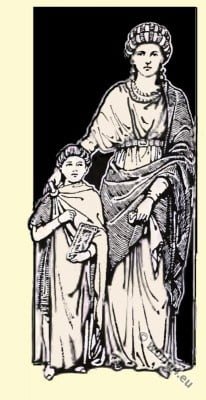
The small youth shown in Fig. 64 is the son of General Stilicho. He wears a short tunica with long close sleeves to the wrist, and over it the colobium, now returned into fashion. Around him is draped the paludamentum. His legs are bare, and on his feet are shoes like those worn by his father.
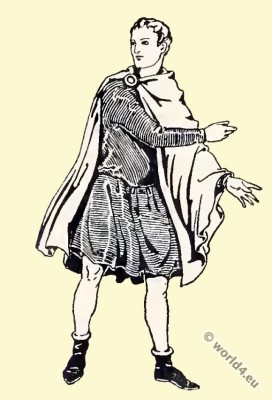
Fig. 62 is a man of position. His tunica of woollen material is of a new shape, and is cut as shown in Diagram 19 with the sleeves all in one. It is of knee length, with long close-fitting sleeves. The upper part of the tunica fits the figure closely and falls in folds from the waist to the knees.
This is the first example of a new style of tunica, which formed the basis of tunicas in general for many centuries, and it will be referred to many times in the future. Over the tunica is a short cloak, familiar as the abolla, made of cloth and fastened on the right shoulder with a fibula. His legs are bare, but he is wearing ankle boots.

Fig. 62A represents a man of inferior rank wearing the dalmatica,—it is here belted low down on the waist, almost on the hips. A loose piece of drapery, in the form of a rectangular cloak, is carried over his left shoulder. Many examples show cloaks of various colours, fastened at the neck in front with a circular fibula.
Women fashion 5th century – Imperial costume and the nobility.
The Revival of the Greek Chiton
A strong national Greek tendency stirred the intellectual element of Byzantine society during the last decadent spasms of Imperial Rome, and was the cause of the revival of many traditional fashions of Classic Greece. Not the least important was the costume.
It has been pointed out already that the Roman stola was identical with the Greek chiton, but, with the advent of the dalmatica in the third century, the stola and palla sank into insignificance. It has been shown lately that the palla took a new lease of life in the fourth century.
The Greek chiton, i.e. the stola, returned at the end of the fourth or beginning of the fifth century, with slight modifications. It is shown in Figs. 63 and 64, but more clearly in Diagram 20. This new fashioned stola still retained its original shape as a cylinder, but, instead of being entirely open at the neck and shoulders, the neck part was hollowed out and the arms were passed through the armholes at the sides, after the method of the kolobus *. It was also considerably wider, as the distance from the neck B to the edge of the armhole A was sufficient to allow the material to give the effect of a draped sleeve, the whole width being confined by a girdle worn rather high at the waist.
To this garment was sometimes added the very ornate latus clavus or the angustus clavus (see Fig. 63).
- The Kolobus, 400-146 B.C. Another form of the chiton came into use about the beginning of the fourth century B.C. In shape it was two pieces of material cut square and sewn together on the shoulders, leaving an opening in the middle for the head, and sewn down the sides with sufficient space left at the top for the ij arms to pass through. Difference between chiton and kolobus. When the kolobus was girded at the waist, it had very much the same appearance as the chiton, the difference being that the arms emerged at the top edge of the chiton and at the side edge of this garment, known to the Greeks as the KOLOBUS, or “short,” in reference to what might be called a sleeve.
There is reason to believe that the Greeks wove the material of this garment in one piece, with the three openings for the head and arms left in the weaving: the whole garment then would be without a seam.
Fig. 63 shows an empress of the fifth century. She is wearing at least four garments. First, an under-dress with tight sleeves to the wrist. Over this is a white stola of the new shape, the draped sleeves only showing. Over this again is a second stola, with the angustus clavus, and over all is draped the palla, with panel attached, and arranged. The girdle is now worn over all the drapery.
The jewelled collar, with pear-drop pearls, is a new fashion which became a distinctive feature of Byzantine dress. Note the sudarium in the left hand.
Fig. 64 shows the costume of a noble lady at the end of the fourth century and first half of the fifth. The new shaped stola is worn, over an underdress with close sleeves to the wrist, and is confined at the waist with a girdle. It is curious to find her with the palla draped in the old-fashioned Greek manner—a fact which proves how much this garment of antiquity was in favour, even at so late a date.
Notice the prevailing fashion of carrying the sudarium in the left hand. The figure is that of Serena, niece of the Emperor Theodosius I. and wife of Stilicho, and is from the Monza diptych. It may be that the costume is not a representation of that actually worn by the lady, but a classic treatment of his subject adopted by the artist. This is doubtful in view of the very modern (fifth century) head-dress which she wears.
Women clothing of the People in 5th century.
Fig. 65 shows a woman of this class. She is wearing the dalmatica, cut as shown in Diagram 18, with the angustus clavus. It could be worn girded at the waist or ungirded. The palla is worn over the head, a portion of the edge being fastened tight round the head. A fold of it is pushed to the front over this tight portion, and the bulk of the palla hangs on both sides of the figure. In this case the wearer has taken the right side hanging portion and draped it over the right arm and left wrist.
Byzantine Empire 6th century
Costume of the 6th Century
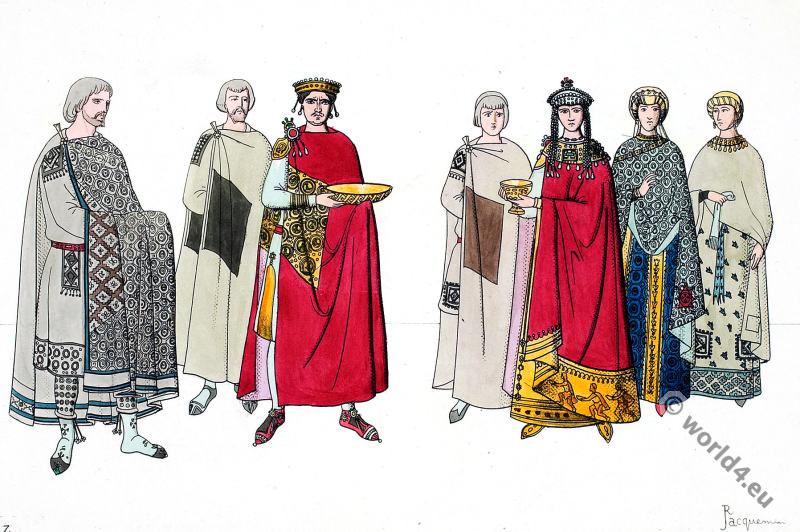
The sixth century is celebrated in the history of costume for three reasons: Firstly, the introduction of the silk-worm into Europe. Secondly, it is in this century that the practice of “faking” (a pernicious habit with modern dressmakers, to say nothing of theatrical costumiers) first came into use in the art of dressmaking.
It started with the pallium and the palla, so the blame rests equally upon both sexes. Thirdly, for the advent of Trousers. These abominable and disgusting garments, so long associated with depraved savages, were adopted by the highly cultured and respectable subjects of a great empire. Men of rank and position now wore close-fitting leg-bags called HOSA. These made their appearance even at Court, for they were worn by the Emperor and his officials. Possibly the fashion was set by that barbarian hero, Theodoric the Great, King of the Ostrogoths. Although the Roman Catholics obliterated Theodoric’s portrait from among the mosaics which decorated the walls of his Arian basilica of S. Apollinare Nuovo at Ravenna, they kept his trousers—for this time these garments had come to stay.
Asiatic trousers.
Drawers, or trousers, besides being the distinctive garb of the barbarian races of the North and West, had been a part of the national dress of the Medes and Persians, the Parthians, Phrygians, Samatians and Dacians for many centuries before the Christian Era.
The more refined Asiatics had them made of silk or cotton, and some were highly decorated with many patterns and stripes. The Magi, or Eastern Kings, are represented in mosaics and in art generally of the fifth, sixth and seventh centuries a.d. wearing these elaborately patterned trousers, to distinguish them as foreigners. By some nations of the East, especially the Persians, these trousers were worn close-fitting and had almost the appearance of long stockings.
The Ostrogothic and Persian Wars of this epoch were factors which brought into favour the use of trousers; and it is at this period—the sixth century—in the history of costume that two names are found for the two kinds of leg coverings—commonly called by us to-day, drawers and trousers.
The old Celtic name of bracco became changed into “broc,” singular, and “brec,” plural, meaning loose or wide leg coverings. From this word is derived “breeks” or “breeches.” In Prankish and old French it became “braies.”
A new word now crept into the languages of Europe. In Latin and Teutonic this word was “hose,” meaning a tight or close leg covering. In Anglo-Saxon it became “hose.” The name “hosa” is the one by which in future we shall know the tight-fitting leg covering worn during the next few centuries.
Men clothing 6th century – Imperial costume and the nobility.
The chief authorities for the costume of this century are the mosaics in the basilicas of S. Vitale and S. Apollinare Nuovo at Ravenna. The former are dealt with first, as they represent the nobility in Court dress.
The Emperor Justinian (a.d. 527-565) in State is seen in Fig. 66. The tunica is but slightly varied from that shown in Fig. 60 except in the arrangement of the segments. The paludamentum is also very similar, but made of heavier and richer silk, specially woven for him on his own looms. It is fastened by a jeweled fibula with three strings of pearls attached, and is lined with silk of another color. The tablion is of brocade or embroidery depicting birds in circles.
The most interesting point is that the Emperor is wearing on his legs the new hosa, made of silk. The shoes show the transition from the sandal of Fig. 60 to an indisputable shoe. The crown is of a new shape, much more elaborate, and is dealt with under Jewellery (p. 203). Fig. 67 is that of the Emperor Justinian riding, and is taken from a silver disc found in a tomb at Kertsch in the Crimea in 1891, now in the Hermitage, Petrograd. He wears the short tunica, open up the sides, and embroidered with bands and segmentae.
The clavus of decorative needlework now terminates, above the waist-line, in leaf-shaped ends. (The clavus arranged in this manner continued in use well into the eleventh century.) The belt at the waist, and the sword belt over the shoulder, are decorated with goldsmith’s work and set with precious stones. The coronet is composed of pearls, with a jewelled clasp in the centre; it is similar to that shown in Fig. 60, but now worn on semi-State occasions.
The hosa are plainly seen, and the feet are shod with embroidered leather shoes, fastened with a strap across the instep. This dress would be worn at a semi-State function; and, for full State on horseback, the paludamentum would be added. This drawing gives the correct horse furniture of the time.
The Official Dress of the Byzantine Consuls
The Toga Picta Contabulatum, the Secular Pallium and the Lorum.
Consuls under the Roman Empire were the official representatives of the Senate. The title of consul was also an honorary one, conferred upon the governors of provinces outside Italy, who were elected by the Senate and sanctioned by the Emperor. The title continued in Rome and Constantinople until the sixth century a.d. About this time the office of the consulate was divested of its power. It reflected the glory of illustrious men who had gone before, and, as such, was much coveted as a title of honour. Foreign potentates, tributary and barbarian kings, princes and chiefs were propitiated by the title being conferred upon them.
The appointment of a consul was marked by much ceremony, and it was one of the customs for the consul, when assuming his office, to present his portrait, arrayed in his insignia, to the Emperor and to his friends. These portraits were carved in ivory, with the donor’s name and other representations in bas-relief, and were formed of two (sometimes more) tablets or panels, hinged together, and called “diptych” — diptych.
Writing utensils. — Diptycha. The word in Greek, díptychos meaning “to fold,” applied originally to two wooden lids, hinged together, in which black wax was run for the purpose of writing on with a “stilus,” which left a white line upon the black wax. The stilus was like a pencil, made in bronze, iron, wood, or ivory, with a point at one end, and a knob, to be used for obliterating what had been written, at the other. This was called by the Romans “Tabulae.” Another Roman name for two panels hinged together was “Diplomae”; and these were letters-patent, conferring government grants, passports, certificates, etc., and were generally of bronze with the name and wording cut in. The insignia of a consul consisted of the tunica talaris, with long, fairly close sleeves, generally embroidered at the wrists. Over this was worn the tunica palmata, which descended to half-way below the knee. The sleeves were wide, and came to just above the elbow or wrists. On the feet were boots — The Calcei.
In his left hand he carried the “Scipio Eburneus,” a sceptre of ivory surmounted by an eagle, and used by a consul or magistrate only at the games.
In his right hand he held the “mappa” (usually shown in diptycha folded like a pad) of white, which he used only at the circus, to give the signal for the games to begin (see Figs. 68 and 69). The most important part of the paraphernalia was the toga picta. First method used till 450. Up to the middle of the fifth century, the toga picta was worn after the manner of the toga umbo, but instead of allowing the end at point F to hang behind or trail on the ground, it was brought round the front of the figure, draped over the right thigh, and the end carried over the bent left forearm. Second method used about 487.
Later—that is, towards the end of the fifth century—the toga picta was put on first in the usual way, and, according to the diptych of Boethius, consul in 487 (see Fig. 68), the pallium is separate, and placed on top. It started at point A in the centre-front, passed over the right shoulder e, but where it next went is a matter of conjecture; probably it took the same course as shown in Fig. 70. The toga picta also started at point A underneath, and, having passed over the left shoulder B, it crossed the back, passed under the right arm c, over the front, and the remainder draped over the left shoulder and forearm d. The sleeve of the tunica palmata is seen at F.
The ornamentation of the toga picta was with the addition of a band of embroidery on the inside to match the rest of the design worked on the straight edge. Being folded back, this gave the panel effect which was so like the pallium. There is no doubt that at this stage of development the band of embroidery was fixed on, as we fix on a cuff or fix up the bottom of trousers to-day.
Later, in all probability for the sake of convenience, the arrangement of the last method was faked. The toga picta may have been cut in two unequal parts across the segment, and the front or larger portion supplemented by a band, until it reached that point where it passes through the loop at c. Here the remaining or smaller part of the toga picta was pleated on to the end of the band.
Unfortunately, the same design of ornament was used for the decoration of both the toga picta and the pallium. This, together with the fact that the backs of the figures of the consuls never can be seen, makes the arrangement very difficult to understand, even by careful study of the diptycha.
After the abolition of the office and title of consul in the sixth century, the panel, or pallium as it was in reality, became entirely detached from the toga picta, and evolved into a mere scarf or band, most gorgeously decorated with gold, jewels, and great quantities of pearls. It measured from nine to twelve inches in width, and about eighteen feet long. This secular pallium, or as it was sometimes called, the LORUM (see Fig. 70), from the Latin “Limbus”, meaning a border, band or scarf, became an item of Imperial insignia, and was much used from the eighth to the twelfth century as an ornament worn with Byzantine Court costume.
How it was put on. As usual it started at a, then it passed over the left shoulder B, making a loop at the back c, and returning over the right shoulder d; thence across the chest, under the left arm at waist level to the back, it passed through the loop at c. The remainder was brought round the right thigh F, across the front, and carried on the left forearm G. This arrangement could be reversed, the lorum passing first over the right shoulder, round the back to the left shoulder, under the right arm, through the loop, and returning under the right arm, across the front, and carried as before on the left wrist.
The Dress of Byzantine Nobility in 6th century
The costume of a courtier is shown in Fig. 71. He wears the short tunica (embroidered with segmentae — a design for a square one is shown in the top corner), already described under Fig. 60 and Fig. 66, and above it the paludamentum descending to the ankles. Both the tunica and paludamentum are frequently shown in white in mosaics; in one case a sulphur-coloured one is depicted, with the tablion in plain purple. The tablion shown in this figure is more ornate. On his legs are the hosa, and he wears shoes of a new shape.
Fig. 71A is also a nobleman of this period, wearing ordinary dress. The tunica is longer than usual, and the manner of girding it with a small scarf to form a pouch—”kolpos”—at the sides should be noticed. This nobleman is wearing the toeless boots.
Fig, 72 shows the costume of a man of some position, wearing the tunica, girded at the waist, from whence hangs a POUCH, pocket or wallet. The cloak is a rectangle, fastened as usual on the right shoulder. On his legs are high cloth boots.
Fig. 72A is that of a young man of the middle class. The clavus, it should be noticed, is of the new design, and extends only to just above the waist-line.
Fig. 72B is an older man, and one of decided religious convictions. On the end of his waist-belt or scarf is worked a cross. His legs and feet are bare, quite a usual occurrence even at this time.
Hairdressing of the Men, a.d. 400-1200.
The first example of the style of hairdressing in vogue throughout this long period is described under Imperial Rome, fourth century, and shown in Fig. 44. This fashion of wearing the hair continued during eight centuries, the length, fulness, and crispness varying slightly at different times, as shown in figures illustrating the costume of this epoch.
400 to 800. In Fig. 73 is seen a head of hair dressed in the customary way. It is cut to form a fringe over the forehead, and sufficiently long at the back to allow it to puff at the nape of the neck. With the brush and comb it is arranged to radiate from the crown of the head. (The segmentae and neck-band of the sixth century are worthy of notice.)
741. Constantine IV. (668-685) arrived at Constantinople after his accession, a youth with a sprouting beard, and in consequence the nickname “Pogonatus” has clung to him through history. His portrait at Ravenna shows him clean shaven.
800. Until the ninth century, it was quite the exception to wear beards and moustaches. The emperors and the noble show that by this time (900-1000) the wearing of beards and moustaches was the correct thing. 1200. Patches of hair on the cheeks were now obsolete.
Women clothing 6th century – Imperial costume and the nobility.
Fig. 74 shows the State costume of the Empress Theodora, the details of which are taken from the same source as those of the Emperor (see Fig. 66), i.e. S. Vitale, Ravenna. The architecture in the background is founded on details from S. Vitale, Ravenna. The stola of white is ornamented with gold and emeralds, following the lines of the decoration seen upon the tunica worn by the Emperor. Over this she wears, by special concession, the paludamentum of purple, lined with blue, and embroidered inside and out with a rich border in gold. On the outside, above the lower border, are embroidered figures of Asiatic character —the Magi—in gold. Surmounting the paludamentum is a heavily jewelled collar, and upon the fashionable head-dress is posed the Imperial diadem in gold, pearls and emeralds. Ropes of pearls, ending in fine specimens of pear shape, hang from the diadem.
Fig. 75. The Lady Antonina (from the same mosaic) is wearing either a dalmatica or the stola. The sleeves are not indicated very clearly in the mosaic, but the presence of the highly decorated angustus clavus points to the garment being the dalmatica. In the original, it is of a red purple, with the gold clavus embroidered with red, white, and green flowers.
Over this is worn a garment differing slightly from any hitherto described (unless the paenula is taken into account) — a semicircular cloak (see Diagram 21), for such it must be, as it resembles very closely the paludamentum, the regal garment prohibited to any woman except the empress. It is of patterned white silk material, and, since brocades were not woven in Byzantium at such an early date, it is possibly of Chinese or Persian origin. Segmentae in red and gold are embroidered in the two corners.
Description of costume of noble ladies. The mosaic at Ravenna also shows six other ladies in attendance on the empress, three of whom are in the background. They are dressed in a similar fashion, but the colourings of their garments differ.
The second lady is wearing the stola of white, figured in blue, with segments in gold, white, and green. The cloak is of gold, embroidered with red roses of Byzantine design, slipped green.
The third wears a cream stola, worked in green, possibly a Chinese brocade. It has a deep border, and the segmentae are in black and white. The cloak is of white, with gold segmentae in the corners.
The fourth wears a green stola, figured with red, and a cloak of red flowered with green and gold. The third and fourth ladies show the white ends of the scarves that are tied round their waists, and all seven of them wear the fashionable head-dress.
Mosaics at S. Apollinare Nuovo, Ravenna, represent twenty virgin martyrs, who are depicted in the costume of noble ladies of the sixth century. One of them (S. Agnes) is shown in Fig. 76. All the twenty wear practically the same dress, with slight variations. It consists of an under-stola, showing only the close sleeves to the wrists.
Over this is worn the new chiton in white (Diagram 20), cut wide enough to form draped sleeves well on to the wrists. It has the angustus clavus in black and gold. Over all is the gold palla, with a border of sapphires and pearls, the panel of blue edged with red being attached to it, but with a difference which is new.
Having crossed the left shoulder for the first time, as usual, the palla is drawn across the back, and pulled over the right shoulder, and a bit of its top edge is caught down to the belt in front. The bulk of the palla falling behind the right arm is pulled across the front, having passed under the right arm, and flung over the left shoulder. It will be found that by this arrangement a cape-like sleeve is formed on the right shoulder. At this stage it is belted over all by a rich girdle, with a large ornament of jewels in the centre, but leaving the long end free to hang down the back. The figure is holding this end in the right hand. It should be noticed that a small portion of the white chiton is visible at the chest. At the neck the border of jewels forms an apparent necklace.
The hair of these twenty women is dressed after the fashion shown in Fig. 59, but a band of gold and jewels is worn round the top, and the hair is puffed out above it. From this band hangs a white gauze veil with fringed ends.
Middle-Class Women clothing 6th century
Fig. 77 shows a woman of the middle class, wearing the shaped dalmatica, ungirded. The sleeves of the stola are seen at the wrists. On the head is worn a cap, following the shape of the head-dresses worn by the nobility, but this one is made of plain white linen, with a roll brim and soft crown.
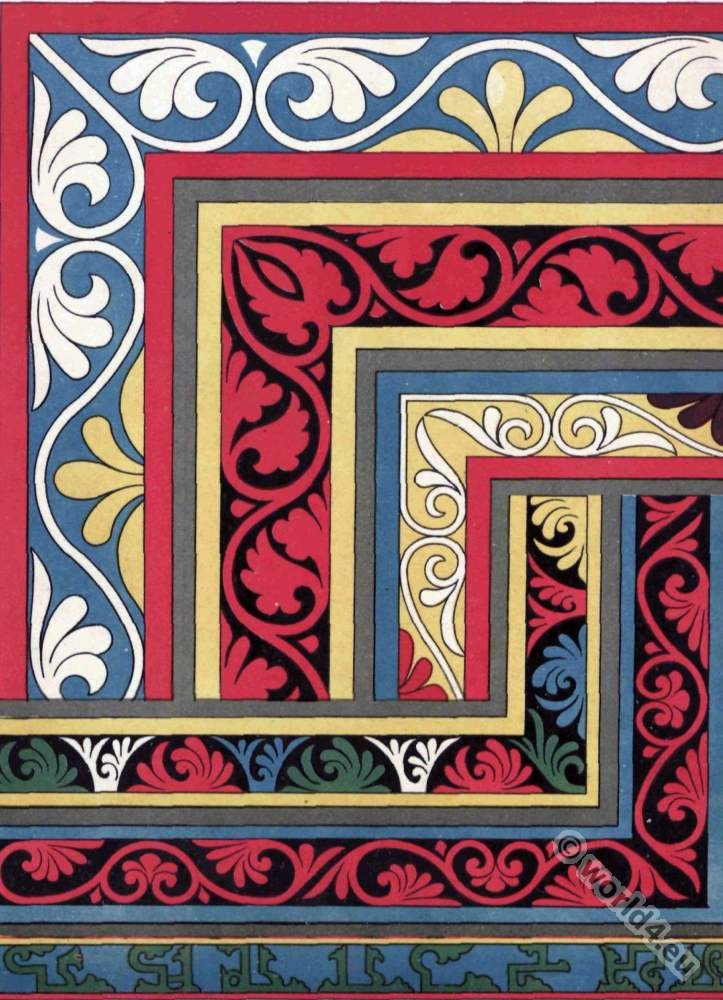

Women’s Head-dresses 6th century.
Towards the end of the fourth century, a headdress of a curious nature came into fashion. Decidedly of Eastern origin, it resembled the Oriental turban, and it remained an official and fashionable coiffure for several centuries.
It was a circular roll or pad, with a close-fitting cap inside it, and is described more explicitly by comparing it to a skull-cap surrounded by a miniature motor tyre.
A.d. 350. In its first stage of development, the cap part of this headdress was of larger dimensions, and is seen in Fig. 64. In this example the roll, which fits close to the head, is ornamented with narrow bands set at equal distances from one another all round. Similar bands are also set over the rather large cap or crown. This large cap did not remain long in fashion, and it soon gave place to a close-fitting skull-cap with the roll surrounding it. Head-dresses of this shape are worn by the group of ladies seen in the mosaic at S. Maria Maggiore at Rome, dated 352-366. The figures are all wearing the dalmatica, as it is particularly characteristic of Byzantine dress, although it was worn also at Rome.
A.D. 400. The empress in is wearing this kind of coiffure, but with the difference that the Imperial coronet is placed on top, thereby masking the cap from view.
Fig. 78 shows this head-dress. The bands are now reduced to five in number, and are about one and a half or two inches in width, edged with pearls; and above the roll, masking the cap, is placed a jewelled coronet. The profile drawing shows the cap without the coronet. No hair is visible, but sometimes two small curls were worn on the temples, as if to establish the fact that the wearer had hair, and of a certain colour. The roll is shaped to fit the head, forming a drooping curve over the forehead, and fitted close in front of the ears, entirely covering the top of them but leaving the lobes exposed.
During the sixth century this coiffure became a recognised part of the insignia of empresses and Imperial ladies; and it continued in use as such, with slight modifications, during the whole period of the Byzantine Empire. There were, however, restrictions with regard to its colour. For Imperial use, the roll was of black, purple, or red. The cap and roll were usually different colours. Many drawings of this period show the roll black and the cap red. Lighter colours only were worn by women of less exalted position. Over the back part of this head-dress was often draped a veil.
The Empress Theodora (see Fig. 74) shows the roll in black, with bands of gold enriched with jewels and pearls decorating it in five places, one in the centre of the forehead and two on either side. There are probably others at the back which are unseen. This is surmounted by the elaborate Imperial diadem, with many ropes of pearls attached to it.
Fig. 75 wears the same type of head-dress as seen in Fig. 78. The roll is also worn by the empress in Fig. 91. In course of time the shape of this head-dress was adopted by women of the middle class. Theirs was but a simple version of the original, and made chiefly of white linen. A woman of the sixth century is shown in Fig. 77.
Source: Costume and Fashion. The Evolution of European Dress trough the Earlier Ages By Herbert Norris. London and Toronto. J.M. Dent and Sons LTD. New York: E.P. Dutton and Co. 1924.

